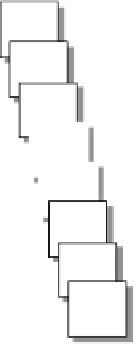Information Technology Reference
In-Depth Information
Secondary
station
1
Commands
Primary
station
Responses
Secondary
station
254
Figure I.4
HDLC addressing range
If there are a large number of secondary stations then extended address can be used to ex-
tend the address field indefinitely. A 0 in the first bit of the address field allows a continua-
tion of the address, or a 1 ends it. For example:
XXXXXXX1 XXXXXXX0 XXXXXXX0 XXXXXXX0
I.2.6 Control field
The control field can either be 8 or 16 bits wide. It is used to identify the frame type and can
also contain flow control information. The first two bits of the control field define the frame
type, as shown in Figure I.5. There are three types of frames, these are:
•
Information frames.
•
Supervisory frames.
•
Unnumbered frames.
When sent from the primary the
P/F
bit indicates that it is polling the secondary station. In
an unbalanced mode, a secondary station cannot transmit frames unless the primary sets the
poll bit.
When sending frames from the secondary, the
P/F
bit indicates whether the frame is the
last of the message, or not. Thus if the
P/F
bit is set by the primary it is a poll bit (
P
), if it is
set by the secondary it is a final bit (
F
).
The following sections describe 8-bit control fields. Sixteen-bit control fields are similar
but reserve a 7-bit field for the frame counter variables
N(R)
and
N(S)
.
Information frame
An information frame contains sequenced data and is identified by a 0 in the first bit position
of the control field. The 3-bit variable
N(R)
is used to confirm the number of transmitted
frames received correctly and
N(S)
is used to number an information frame. The first frame
transmitted is numbered 0 as (
000
), the next as 1 (
001
), until the eighth which is numbered
111
. The sequence then starts back at 0 again and this gives a sliding window of eight
frames.





























